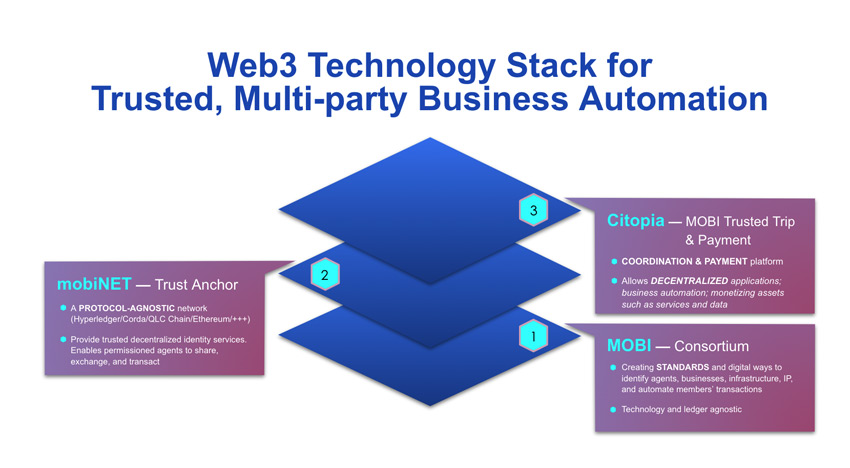This is a guest opinion post from Tram Vo, Co-director + Founder, MOBI.
The convergence of multiple rapidly maturing technologies, such as AI, IoT, and blockchain, permits any connected entity — whether a person, vehicle, device, package, piece of infrastructure, or data set — to communicate and autonomously participate as an independent economic agent in transactions. These usage-based (pay as you go) economy-of-things transactions will:
- Create new opportunities to monetize mobility assets such as infrastructure, vehicles, roads, and connected data
- Enable a less centralized transportation ecosystem
- Generate new usage-based decentralized mobility applications such as seamless travel using different modes of transport, urban road tolling, congestion pricing, usage-based insurance, incentives for green and sustainable behavior, supply chain track and trace, and numerous other use cases that we have yet to imagine.
These transactions — the exchange of value, goods, and data between entities in the economy of things — will produce a multi-trillion-dollar pay-per-use ecosystem we’ve termed The New Economy of Movement.
The New Economy of Movement requires a new way of identifying people and things, one which is blockchain-based, self-sovereign, decentralized, and machine readable. These are known as decentralized identifiers (DIDs).
DIDs give individuals and organizations the power to own and control their digital identifiers, breaking the reliance on third party authenticators and centralized authorities. In a decentralized system, DIDs are embedded in Verifiable Credentials (VCs). Those VCs may be created by trusted entities, such as government agencies, businesses, universities, or employers and issued to a “holder” of the VC. If we think of the DID as a global ID, then VCs are like digital passports, or unique stamps which serve to attest to specific information about an entity associated with a specific DID.
In the New Economy of Movement, Web3 federated networks and decentralized platforms are needed to manage DIDs and VCs to enable trusted data sharing and business automation. MOBI’s Web3 infrastructure consists of three member-owned and operated layers — collectively the MOBI Technology Stack (MTS) — needed to verify decentralized transactions between connected entities. Each layer with a different architecture and function, together forming a holistic approach to Web3 applications developed for decentralized connected ecosystems.
The three layers are illustrated below. The foundational layer is the MOBI consortium, which creates standards to identify connected entities and shared business processes. The middle layer is mobiNET, a layer-two, protocol-agnostic digital infrastructure to provide trusted decentralized identity (DID) services. The top layer is Citopia, a trustless decentralized platform to onboard DIDs and enable VC issuance for business automation; monetizing assets such as infrastructure, services, and data.

MOBI Trusted Trip Credentials, Verifiable Identity and Location
Beginning with Vehicle Identity (MOBI VID, a vehicle’s digital twin based on the internationally accepted vehicle identification number, or VIN) in 2019, MOBI has published thirteen blockchain-based standards (including nine in 2021) outlining sustainable decentralized solutions for digital identity management, supply chain, vehicle electrification, mobility data, and mobility-related IoT commerce. The most recent of these — the MOBI Trusted Trip (MTT) Standard — is perhaps the most important pillar of the New Economy of Movement.
For a trip to be useful to entities in a decentralized usage-based ecosystem, it must be trusted by all entities in the transaction. The MTT Standard links an entity’s DID with its timestamped location in the form of VCs and enables the linkage to be certified throughout any trip in a trusted network. It is the key to decentralized privacy-preserving pay-per-use mobility.
MTT Verifiable Credential is based on W3C’s DID and VC Specifications. Using DIDs allows holders, on their own terms, to share trusted data with other verified entities without disclosing identity-related information and other selective attributes. MTT allows a holder of such credentials to prove to verifiers that it was present, completed a trip, used a resource, provided a service, or performed other relevant activities while safeguarding their Personally (or organizational) Identifiable Information (PII). MOBI Trusted Trip is the key primitive of the multi-trillion-dollar New Economy of Movement.
Linking decentralized identities with reliable and immutable location tracing, provenance, and chain of custody for data, people, and devices enables business automation and interoperability in the economy of things. This includes a huge new class of automated pay-per-use services in The New Economy of Movement. Specifically, MOBI Trusted Trip enables marginal cost pricing – where users are charged based on the additional cost, including social cost, of what they consume – for many new classes of transactions such as:
- Settlement of insurance claims and premium calculation for usage-based insurance
- Calculation and settlement of toll and congestion charges
- Verification of chain of custody for physical asset transfer and service payments
- Verification of emissions claims to issue carbon credits/offsets
- Verification of vehicle maintenance, battery state-of-health, etc.
- Verification of route waypoints and safety parameters for both offroad and on-road assets
- Supply chain management; especially physical provenance of parts
- Finance and securitization — e.g., floor plan audits
- Telecommunication and mobile connectivity — e.g., mobile home office, knowing the mobile assets location for security services, and mobile endpoints
- Other use cases that require location and time-based proofs of static and mobile assets
Movement reveals our most valuable preferences and behaviors. Web3 holds the potential to expose new dimensions of our personal data, while giving us the tools to control, protect, and monetize it. Web3 business models will upend and outcompete today’s dominant Web2 centralized platforms as quickly and decisively as those Web2 platforms replaced the platforms that dominated earlier industrial and digital eras.
MOBI participants and other adopters will enjoy access to the cutting-edge markets, customers, and business models made possible in the New Economy of Movement. More importantly, the architectural and business decisions made by Web3 pioneers, including the MOBI community, will determine the experience of future users.
Will Web3 realize the original web vision of decentralization, equal access, and fairness? Or will it strengthen the market power of centralized platforms? We hope that the MOBI community, through their contributions to the New Economy of Movement, can positively influence the outcome.






